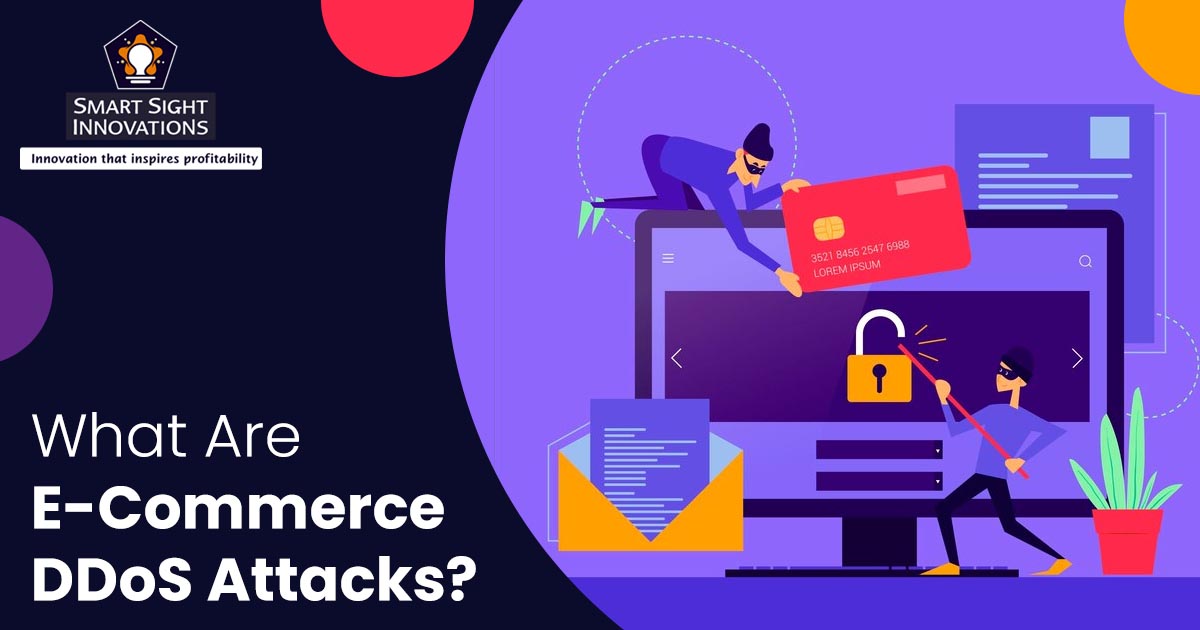
E-commerce thrives on constant online availability, but what happens when a malicious attack cripples your website? DDoS attacks pose a significant threat, overwhelming online stores with floods of traffic.
This article explains e-commerce DDoS attacks, how they work, the different attack methods, and the devastating impact they can have on businesses. We’ll also equip you with valuable strategies to mitigate these attacks and ensure a smooth online shopping experience for your customers.
What Is a DDoS Attack?
Malicious attempts to stop a server, service, or network from operating normally are known as distributed denial of service (DDoS) attacks.
Imagine a crowd flooding a store entrance, making it impossible for real customers to enter. A DDoS (Distributed Denial-of-Service) attack is similar. It maliciously overwhelms a website or online service with a surge of traffic from multiple devices, like a botnet (network of compromised computers).
This flood of traffic cripples the system, preventing legitimate users from accessing the service. DDoS attacks that target businesses often cause downtime and financial loss.
Importance of Understanding DDoS Attacks in E-commerce
Understanding DDoS attacks is essential for e-commerce businesses to safeguard their financial health, reputation, customer trust, and legal standing.
1. Financial Impact
E-commerce platforms rely on constant, uninterrupted access to generate revenue. A DDoS attack can cause significant downtime, halting sales and leading to substantial financial losses. Additionally, the cost of mitigating such attacks and restoring services can be considerable. Businesses must factor in not only the immediate loss of sales but also potential long-term impacts on revenue streams.
2. Reputation Damage
Reliability and security are paramount in e-commerce. Downtime caused by DDoS attacks can severely damage a business’s reputation. Customers expect a seamless shopping experience, and frequent or prolonged outages can erode trust, pushing customers towards competitors. Maintaining a strong, reliable online presence is essential for customer retention and brand loyalty.
3. Data Security
While DDoS attacks primarily aim to disrupt services, they can also act as a smokescreen for more insidious activities, such as data breaches. During the chaos of a DDoS attack, cybercriminals might exploit vulnerabilities to steal sensitive customer data, leading to severe privacy issues and further financial repercussions.
4. Customer Retention
Customer loyalty in e-commerce hinges on a seamless user experience. Repeated disruptions due to DDoS attacks can lead to frustration and loss of customers, who may seek more stable and secure alternatives. A single negative experience can tarnish customer perception, emphasizing the need for consistent, reliable service.
5. Compliance and Legal Implications
Many jurisdictions have stringent data protection laws. A DDoS attack that results in data breaches or service disruptions can lead to non-compliance with these regulations, attracting hefty fines and legal actions. Understanding and preparing for DDoS attacks helps e-commerce businesses stay compliant and avoid legal pitfalls.
Types of DDoS Attacks Targeting E-commerce Sites
E-commerce sites are prime targets for DDoS attacks due to their need for constant uptime and the sensitive nature of their transactions. Cybercriminals employ various methods and tools to execute these attacks, each with unique characteristics and impacts. By recognizing these, e-commerce businesses can better prepare and implement robust security measures to safeguard their platforms from potential disruptions. Here are the main types of DDoS attacks that can affect e-commerce sites:
1. Volume-based Attacks
Volume-based attacks, also known as volumetric attacks, aim to overwhelm the target site with a massive amount of traffic. This flood of data consumes all available bandwidth between the target and the broader internet, effectively choking off legitimate user traffic.
2. Protocol Attacks
These attacks exploit weaknesses in network protocols to consume resources such as connection state tables on web servers, firewalls, and load balancers. They aim to exhaust the processing capacity of these devices.
3. Application Layer Attacks
Application layer attacks, also known as Layer 7 attacks, target the top layer of the OSI model, focusing on specific web application vulnerabilities. These attacks are particularly dangerous because they mimic legitimate user behavior, making them harder to detect.
4. Botnet-based Attacks
Botnets are networks of infected computers (bots) controlled by an attacker. These bots can be directed to send traffic to a target, creating a powerful and distributed DDoS attack.
5. Reflection and Amplification Attacks
These attacks use legitimate third-party servers to amplify the amount of traffic sent to the target. The attacker uses the IP address of the target to send small requests to third-party servers, which reply to the target with huge answers.
6. Slowloris
Slowloris is a type of application layer attack designed to keep many connections to the target web server open and hold them open as long as possible, exhausting the server’s resources. Slowloris sends the server partial HTTP requests. The server keeps these connections open, waiting for the requests to complete, which eventually consumes all available connections and prevents legitimate users from accessing the service.
7. ICMP Floods
ICMP Floods use Internet Control Message Protocol packets to flood the target. This type of attack consumes both outbound and inbound bandwidth, as the server attempts to process each request.
E-commerce DDoS Trends
As DDoS attacks targeting e-commerce platforms are constantly evolving, understanding current trends is essential for businesses to bolster their defenses and mitigate potential threats. Here are some key trends in e-commerce DDoS attacks:
- Modern DDoS attacks often combine multiple attack vectors, making them harder to defend against. These attacks might simultaneously target different layers of a system, such as volumetric, protocol, and application layers.
- Attackers are becoming more adaptive, modifying their strategies in real-time based on the target’s defensive measures. This adaptability makes it challenging to mitigate attacks effectively.
- The proliferation of IoT devices has led to a surge in botnet-powered DDoS attacks. Many IoT devices lack robust security, making them easy targets for attackers to hijack and use in large-scale DDoS campaigns.
- E-commerce platforms experience heightened DDoS activity during peak shopping seasons such as Black Friday, Cyber Monday, and holiday sales. Attackers exploit these times when the impact of downtime is most severe.
- Special promotions or product launches are also prime targets for DDoS attacks, as disruptions during these events can lead to substantial financial losses and customer dissatisfaction.
- Ransom DDoS attacks involve cybercriminals threatening to launch DDoS attacks unless a ransom is paid. Attackers often demand ransoms in cryptocurrency, making it harder to trace and increasing the appeal of such attacks for cybercriminals.
- Attackers are leveraging automation and artificial intelligence to enhance the efficiency and effectiveness of their attacks. Automated tools can launch and manage large-scale DDoS attacks with minimal human intervention.
- The dark web facilitates the exchange of DDoS services, botnet rentals, and exploit kits, making it easier for cybercriminals to access and deploy powerful attack tools.
Preventive Measures and Best Practices to Mitigate E-commerce DDoS Attacks
DDoS attacks are a realistic threat to e-commerce businesses. Fortunately, there’s a multi-layered approach businesses can adopt to build a robust defense system.
1. Cloud-based Solutions
Utilize cloud-based DDoS protection services such as Cloudflare, Akamai, or AWS Shield. These services can absorb and filter malicious traffic before it reaches the e-commerce platform.
2. Content Delivery Networks (CDNs)
CDNs distribute traffic across multiple servers, reducing the impact of DDoS attacks and improving website performance and reliability.
3. Firewalls and Intrusion Detection Systems (IDS)
Configure firewalls to filter out suspicious traffic and use IDS to monitor and detect potential threats in real-time.
4. Rate Limiting and Throttling
Implement rate limiting and throttling techniques to control the number of requests a user can make in a given time frame, preventing attackers from overwhelming the server with excessive requests.
5. Routine Audits
Conduct regular security audits and vulnerability assessments to identify and address potential weaknesses in the network and application infrastructure.
6. Penetration Testing
Evaluate the efficacy of current security measures and replicate DDoS attacks through penetration testing.
7. Scalable Infrastructure
Design the infrastructure to be scalable, allowing it to handle sudden increases in traffic. This includes using auto-scaling groups and load balancers.
8. Redundancy and Failover Systems
Implement redundancy and failover systems to ensure that critical services remain available even if part of the infrastructure is under attack.
9. Isolate Critical Components
Segment the network to isolate critical components, such as databases and application servers, from public-facing services. This limits the spread of the attack and protects essential resources.
10. Traffic Filtering
Use traffic filtering and access controls to restrict the flow of data between different network segments. Establishing normal traffic patterns through historical data allows for the creation of baselines. Deviations from these baselines can trigger alerts, enabling quicker identification of potential attacks.
11. Real-time Monitoring
Implement real-time monitoring tools to continuously observe network traffic and server performance. Tools such as SolarWinds, Nagios, and Wireshark can offer significant information.
12. Automated Alerts
Configure automated alerts for unusual traffic patterns or behaviors, enabling rapid response to potential DDoS attacks.
13. ISP Support
Implement DDoS mitigation and traffic filtering at the network level in collaboration with Internet service providers (ISPs).
14. Information Sharing
Participate in industry information-sharing groups and collaborate with other organizations to stay informed about the latest threats and mitigation techniques.
15. Awareness Training
Provide regular training for staff on identifying and responding to DDoS attacks. Ensure that employees are aware of the procedures for escalating potential threats.
16. Incident Response Plans
Develop and maintain comprehensive incident response plans that outline the steps to be taken in the event of a DDoS attack. Conduct regular drills to ensure preparedness.
17. Device Management
Ensure that all IoT devices are properly configured and secured, as these devices are often exploited to build botnets for DDoS attacks.
18. Firmware Updates
To fix bugs and enhance security, IoT devices should have their firmware and software updated on a regular basis.
19. Threat Intelligence Feeds
Subscribe to threat intelligence feeds to stay updated on the latest attack vectors and techniques used by cybercriminals. Use threat intelligence to implement proactive measures, such as blocking known malicious IP addresses and updating security configurations.













